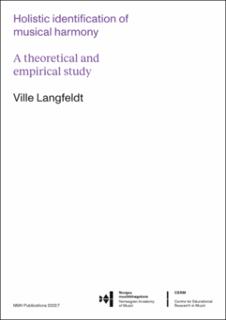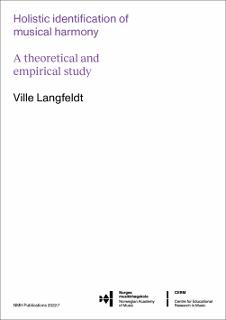| dc.contributor.author | Langfeldt, Ville | |
| dc.date.accessioned | 2022-12-06T12:32:26Z | |
| dc.date.available | 2022-12-06T12:32:26Z | |
| dc.date.issued | 2022 | |
| dc.identifier.isbn | 978-82-7853-312-3 (print) | |
| dc.identifier.isbn | 978-82-7853-313-0 (online) | |
| dc.identifier.issn | 0333-3760 | |
| dc.identifier.issn | 2535-373X (online) | |
| dc.identifier.uri | https://hdl.handle.net/11250/3036128 | |
| dc.description | Dissertation for the PhD degree Norwegian Academy of Music, Oslo 2022 - Avhandling (Ph.D.) - Norges musikkhøgskole, Oslo 2022 | en_US |
| dc.description.abstract | Summary -
This dissertation explores holistic harmony identification. Aural training theorist Gary S. Karpinski depicts this as the most effective and precise form of harmonic listening, but a clear definition and understanding of its nature have been lacking. There has also been a lack of pedagogical strategies for advancing the development of such listening skills in aural training students—indeed, Karpinski questions whether such strategies are possible at all.
The dissertation consists of three parts. The first part is a theoretical study, in which the concept of holistic harmony identification is explored broadly through a combination of Gestalt theory and an ecological approach to perception. The study closes with a discussion of possible pedagogical approaches, including a “metaphorical” approach to harmonic listening. This approach is based on the claim that hearing a chord or progression as something is a way of acknowledging and verbalizing its holistic quality.
The dissertation’s second part is a qualitative document analysis that further explores “metaphorical listening.” Through an analysis of 20 textbooks on harmony, examples of cross-domain mapping in esthesic descriptions of chords and progressions are recorded and discussed. The main aim is to examine whether certain metaphor structures are more recurrent than others, which might suggest a relevance for harmonic aural training. The study’s theoretical framework is conceptual metaphor theory.
The third part is a statistical study that examines one of the metaphors found in the document analysis: harmonic luminosity, or the idea that harmony can express “brightness” and “darkness.” The phenomenon is examined empirically through a web-based experiment with 236 participants. The study shows that harmonic luminosity is likely more perceptually complex than it is portrayed in textbooks using this metaphor. The results also indicate that harmonic luminosity might require some degree of perceptual learning.
The dissertation’s main contribution is a conceptual framework for holistic harmony identification, which both elucidates the concept and enables more targeted pedagogical approaches. In a further exploration of such approaches, novel perspectives on the role of metaphor in musical harmony are offered. | en_US |
| dc.description.abstract | Sammendrag -
Denne avhandlingen utforsker holistisk harmonisk identifikasjon. Evnen til slik lytting er av gehørteoretiker Gary S. Karpinski beskrevet som den mest effektive og presise formen for harmonisk gehør, men har hittil manglet en klar definisjon. Det har også manglet didaktiske strategier for å fremme slike evner hos gehørstudenter, samt enighet rundt hvorvidt didaktiske strategier overhodet er mulige.
Avhandlingen består av tre deler. Første del er en teoretisk studie, hvor holistisk harmonisk identifikasjon undersøkes bredt ved hjelp av gestaltteoretiske prinsipper og en økologisk tilnærming til persepsjon. Denne studien avsluttes med en diskusjon av mulige didaktiske tilnærminger, inkludert en «metaforisk» tilnærming til harmonisk lytting. Denne tilnærmingen baserer seg på påstanden om at det å høre en akkord eller akkordprogresjon som noe innebærer å anerkjenne og sette begrep på dens holistiske kvalitet.
Avhandlingens andre del er en kvalitativ dokumentanalyse som undersøker «metaforisk lytting» nærmere. Gjennom analyser av 20 engelskspråklige lærebøker som omhandler harmonikk, kartlegges metaforer som brukes i beskrivelsen av akkorders og akkordprogresjoners klanglige fremtoning. Målet er å undersøke hvorvidt bestemte metaforstrukturer har en mer allmenn utbredelse enn andre, og dermed kan ha relevans for gehørundervisningen. Det teoretiske grunnlaget for analysen er kognitiv metaforteori.
Tredje del er en statistisk studie som omhandler én av metaforene som ble kartlagt i dokumentanalysen: harmonisk luminositet, eller tanken om at harmonikk kan uttrykke «lys» og «mørke». Fenomenet undersøkes empirisk gjennom et nettbasert eksperiment med 236 deltakere. Studien viser at harmonisk luminositet sannsynligvis er mer perseptuelt komplekst enn det gis inntrykk av i lærebøkene som benytter metaforen. Resultatene antyder også at harmonisk luminositet forutsetter en grad av perseptuell læring.
Avhandlingens primære bidrag er et konseptuelt rammeverk for holistisk harmonisk identifikasjon, som både klargjør konseptet og åpner for mer målrettede didaktiske strategier. Gjennom en videre utforsking av slike strategier bidrar avhandlingen også med nye perspektiver på metaforers betydning i musikalsk harmonikk. | en_US |
| dc.language.iso | eng | en_US |
| dc.publisher | Norges musikkhøgskole | en_US |
| dc.relation.ispartofseries | NMH-publikasjoner;2022:7 | |
| dc.subject | harmonisk lytting | en_US |
| dc.subject | musikalsk harmonikk | en_US |
| dc.subject | musical harmony | en_US |
| dc.subject | harmonic listening | en_US |
| dc.subject | Gestalt listening | |
| dc.subject | Karpinski | |
| dc.title | Holistic identification of musical harmony. A theoretical and empirical study | en_US |
| dc.type | Doctoral thesis | en_US |
| dc.description.version | publishedVersion | en_US |
| dc.subject.nsi | VDP::Humaniora: 000::Musikkvitenskap: 110::Musikkteori: 112 | en_US |
| dc.source.pagenumber | xi, 229 s. | en_US |

